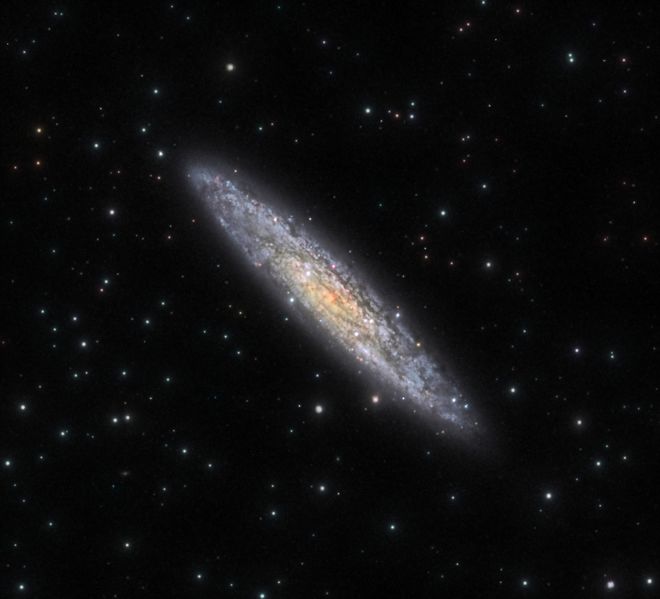
NGC253 'Silver Coin' Galaxy

Barry Brook is a University professor from Tasmania, Australia. He does astronomy from his 'Huon Ridge Observatory' in the dark southern skies lat 43S. He's had a life-long interest in astronomy, forged from his teen years in the 1980s when he was lucky enough to live on site at Siding Spring Observatory Australia's largest professional optical observatory where his Dad worked as an engineer. After years as a visual-only enthusiast, he has recently developed a passion for astrophotography. With endless wonderful southern-sky targets to capture, he'll be kept busy for many years! His Astrobin collection is at http://www.astrobin.com/users/Amaranthus
Details
Date Taken: 08/25/2014
Photographer: Barry Brook
Location: Adelaide, Australia
Telescope: Orion ED80T CF Triplet Apochromatic Refractor Telescope
Mount: Orion Thin Off-Axis Guider for Astrophotography
Other Mount: AZ-EQ6
Camera: Orion StarShoot G3 Deep Space Monochrome Imaging Camera
Other Camera: ZWO ASI120MM-S guide camera
Processing: Startools, Nebulosity, Deepskystacker
Exposure: 15x600 sec Ha, 218x300 sec LRGB
Notes: A deep integration of the famous galaxy brightest member of the Sculptor group. With a visual magnitude of 8.0, it is appears as a long, oval bulge and mottled disk, some 25' x 7' min size true size of some 70,000 light years across, with complex dust lanes north of the core. It is part of a group of galaxies located 11.4 million light years from the Milky Way, and is viewed by us almost side on spiral Sc type, giving it the shape of a coin. There is intense starburst activity in its outer arms, and some prominent HII regions, whereas the core is older and redder with a 5 million solar mass black hole at its centre. The image was captured from suburban Adelaide, using an Orion ED80T CT apo astrograph at f/4.8, mounted on an AZ-EQ6. The CCD camera was an Orion StarShoot G3 mono, guided with PHD2 using a thin OAG and an ASI120MM-S guide camera. The image is composed of the following: Lum = 62 x 5 min Ha = 15 x 10 min R, G
Photographer: Barry Brook
Location: Adelaide, Australia
Telescope: Orion ED80T CF Triplet Apochromatic Refractor Telescope
Mount: Orion Thin Off-Axis Guider for Astrophotography
Other Mount: AZ-EQ6
Camera: Orion StarShoot G3 Deep Space Monochrome Imaging Camera
Other Camera: ZWO ASI120MM-S guide camera
Processing: Startools, Nebulosity, Deepskystacker
Exposure: 15x600 sec Ha, 218x300 sec LRGB
Notes: A deep integration of the famous galaxy brightest member of the Sculptor group. With a visual magnitude of 8.0, it is appears as a long, oval bulge and mottled disk, some 25' x 7' min size true size of some 70,000 light years across, with complex dust lanes north of the core. It is part of a group of galaxies located 11.4 million light years from the Milky Way, and is viewed by us almost side on spiral Sc type, giving it the shape of a coin. There is intense starburst activity in its outer arms, and some prominent HII regions, whereas the core is older and redder with a 5 million solar mass black hole at its centre. The image was captured from suburban Adelaide, using an Orion ED80T CT apo astrograph at f/4.8, mounted on an AZ-EQ6. The CCD camera was an Orion StarShoot G3 mono, guided with PHD2 using a thin OAG and an ASI120MM-S guide camera. The image is composed of the following: Lum = 62 x 5 min Ha = 15 x 10 min R, G
Astro-images taken through a telescope on a tracking mount provide breathtaking color and detail that you just can't see with your eyes alone. The astro-images on our web site demonstrate the imaging capabilities of the products used and are not intended to represent what you will see when you look through a telescope. Learn More
Some materials in our Resource Center require Adobe Reader. Download Adobe Reader here. Adobe Flash Player may be required to view some content. Download the Flash Player here.
Sign up for email
X
and receive updates about
sales, new products, and astronomy.
sales, new products, and astronomy.
Please enter a valid email address
You can unsubscribe at any time.
Thank you!
Watch your inbox for our welcome email.
And consider adding our email address (news@oriontelescopenews.com) to your email safe senders list, address book or contact list.
Then you won't miss news about our sales, new products, or our popular monthly What's In The Sky newsletter.
Welcome Back
You're already on our email list,
so you'll continue to be the first
to hear about our new products
and special offers.




















